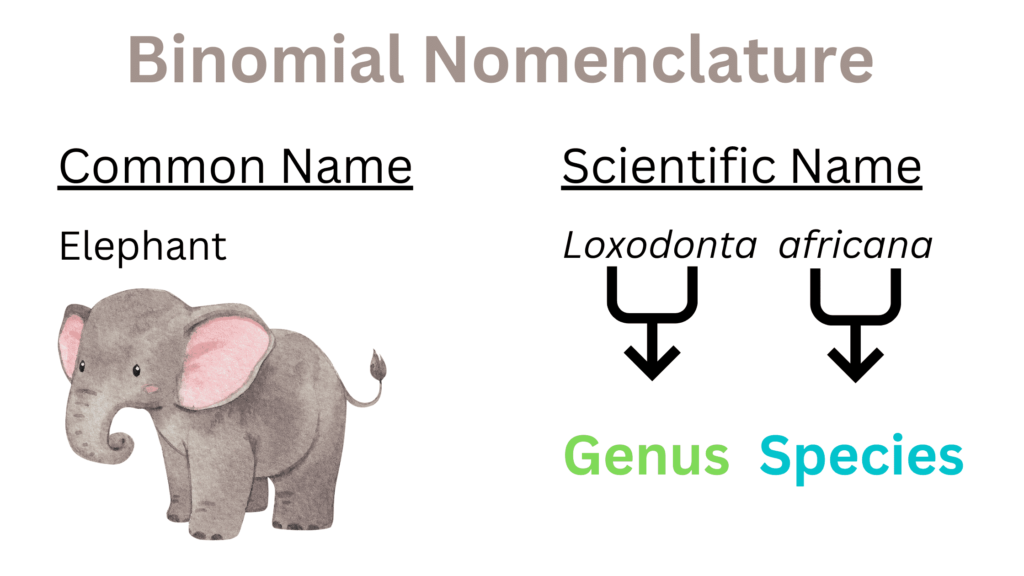Binomial nomenclature is a universally accepted system for naming organisms scientifically. This system assigns each organism a two-part Latinized name consisting of its Genus and Species. It helps avoid confusion caused by multiple common names for the same species across different languages and regions.
History and Development of Binomial Nomenclature
Binomial nomenclature is the formal system of naming species of living organisms by assigning them two Latinized names: a genus name and a specific epithet. This system, which is now universally adopted in biological classification, was developed by Carl Linnaeus, a Swedish botanist and taxonomist, in the 18th century.
A. Early Naming Systems and Predecessors
Before the establishment of binomial nomenclature, species were named using polynomial nomenclature, where organisms were described using long, often inconsistent, Latin phrases. These descriptions varied among naturalists and lacked a standardized structure.
Ancient Greek and Roman Contributions – Early scholars such as Aristotle (384–322 BCE) and Pliny the Elder (23–79 CE) attempted to classify organisms based on their observable characteristics. However, these classifications were broad and not universally standardized.
Medieval Botanical Works – During the Renaissance, herbalists and scholars like Otto Brunfels (1488–1534), Hieronymus Bock (1498–1554), and Gaspard Bauhin (1560–1624) made efforts to describe plants systematically. Bauhin, in particular, was one of the first to use two-part names in his works, foreshadowing Linnaeus’ system.
B. Linnaeus and the Standardization of Binomial Nomenclature
Carl Linnaeus revolutionized taxonomy with his publication of “Systema Naturae” (10th edition, 1758) and “Species Plantarum” (1753), where he formally introduced the binomial naming system. This system followed specific principles:
Two-Part Name – Each species is given a genus name (capitalized) and a specific epithet (lowercase), both written in italics or underlined.
Example: Homo sapiens (human), Panthera leo (lion).
Latin or Latinized Names – Latin was chosen as it was the scholarly language of the time and allowed for universal understanding.
Hierarchy in Classification – Linnaeus also introduced a hierarchical system of classification, dividing life into Kingdom, Class, Order, Genus, and Species.
Standardized Rules – The principle of priority (first published name is valid) and type specimens (reference specimens for each species) were later incorporated into zoological and botanical nomenclature.
Principles of Binomial Nomenclature
The naming system follows specific rules set by international organizations such as:
- International Code of Zoological Nomenclature (ICZN) – For naming animals.
- International Code of Nomenclature for algae, fungi, and plants (ICN) – For naming plants and fungi.
Structure of a Scientific Name
Each organism’s scientific name consists of two parts:
1. Genus name – Always written with a capital letter.
2. Species name – Always written in lowercase.
Example:
Homo sapiens (Humans)
Panthera leo (Lion)
Canis lupus (Wolf)

Rules of Binomial Nomenclature
1. The scientific name must be in Latin (or Latinized form).
2. The Genus name starts with a capital letter, while the species name is written in lowercase.
3. Scientific names must be italicized in printed texts or underlined when handwritten.
4. Names must be unique and follow the rules set by respective nomenclature codes.
5. If a species is reclassified, its earlier valid name is retained (principle of priority).
Importance of Binomial Nomenclature
1. Universality – Used by scientists worldwide, eliminating language barriers.
2. Clarity and Precision – Avoids confusion caused by common names.
3. Classification and Organization – Helps in the systematic grouping of organisms.
4. Indicates Relationships – Reflects evolutionary relationships among organisms.
Examples of Binomial Nomenclature in Different Organisms
| Common Name | Scientific Name | Genus | Species |
| Human | Homo sapiens | Homo | sapiens |
| Dog | Canis lupus familiaris | Canis | lupus familiaris |
| Cat | Felis catus | Felis | catus |
| Mango | Mangifera indica | Mangifera | indica |
| Rice | Oryza sativa | Oryza | sativa |
| Banyan Tree | Ficus benghalensis | Ficus | benghalensis |
Conclusion
Binomial nomenclature is a standardized and essential system for naming organisms. It simplifies scientific communication and ensures consistency in biological classification. Carl Linnaeus’ system remains the foundation of modern taxonomy, helping scientists globally study and understand biodiversity efficiently.
Recommended Posts: The Living Word




